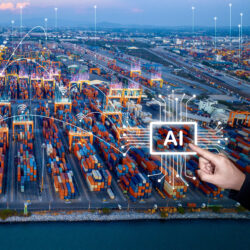The quest to apply AI: ‘Don’t focus on finding a killer app’

Since ChatGPT’s breakthrough two years ago, every business has realized that artificial intelligence (AI) offers great opportunities. To provide guidance in the search for meaningful applications of AI, Supply Chain Media has worked with Carlos Cordon to create a mindmap. The IMD professor explained more during Webinar Wednesday. ‘Go for substantial improvements rather than the fun gadgets.’
By Marcel te Lindert
Since ChatGPT’s breakthrough in late 2022, AI has been attracting strong interest from CEOs. ‘They are convinced that AI will solve many of their problems. Not only because they really believe it, but also because they need it. Many companies are struggling with rising costs and are forced to operate more efficiently. Thanks to ChatGPT, they realize the potential of AI in general and generative AI (GenAI) in particular,’ states Carlos Cordon. He is a professor of strategy and supply chain at IMD Business School and co-founder of Supply Chain Companions together with Martijn Lofvers of Supply Chain Media.
Yet two years on, only 14% of companies have implemented GenAI in their supply chain, Gartner research shows. That seems low, but Cordon is not worried. ‘Many companies start with a proof of concept. Only when that catches on do they implement the technology on a large scale. In addition, there are many questions surrounding AI, such as privacy and cybersecurity. Therefore, companies are cautious, but they know that they will have to start using the technology at some point. This is evident from the same survey, which states that 50% will start working with GenAI in the next 12 months.’
Tighter laws and regulations
Together with Lofvers, Cordon created a mindmap of AI in supply chain. To do so, they first mapped the main trends. One of these is the ever-tighter laws and regulations, such as the Corporate Sustainability Reporting Directive (CSRD) forcing companies to map their carbon emissions. ‘Scope 3 emissions in particular require a huge amount of data from the entire supply chain. Companies do not have the people and resources to collect that data in traditional ways,’ Cordon claims. ‘Current sustainability reports are already three times the size of annual financial reports. Now there’s a chance that they will need to grow tenfold. Companies will only be able to produce such comprehensive reports with the aid of digitization.’
Step two consisted of analysing the impact these trends have on companies. Cordon mentions the CFO, who has to allocate the investment budget. This is especially difficult now that, within many companies, a large part of the budget is spent on migration to SAP S/4 HANA, the new version of the ERP system. Many CFOs therefore refer to the major disruptions of recent years, which many companies have managed to get through with often no more than Excel as a tool. Why is that no longer good enough now? ‘Because many supply chain professionals have left the discipline due to a burnout. They worked really hard and kept their companies afloat, but it took a huge toll on them. We need smarter tools to manage all the disruptions better.’
Resilience and agility
What are the challenges in the supply chain? To answer that question, Lofvers cites a joint study by Supply Chain Media and consultancy firm Efeso. In it, resilience and agility are cited as the main challenge, followed by cost cutting. Cordon is not surprised that implementation of AI only comes fifth. He points out that AI is merely a means to an end. ‘Adoption of AI can actually help make your supply chain more resilient and agile. And also to save costs.’
Before Cordon discusses the solutions AI can provide, he stresses that application of this technology is not new. Classic forms of AI such as linear programming have been widely implemented over the past 10 to 20 years. ‘The user interface is the reason why AI is attracting so much attention now. People are surprised by the ease with which ChatGPT can be used. When we ask a question, we get a clear answer back,’ explains the IMD professor. ‘The success of the iPhone showed how important a good user interface is.’
‘We will always need people’
Research shows that production planning and supply chain planning are seen as the main application areas of AI, followed by forecasting. ‘These are tasks that involve a lot of manual work. AI can help eliminate that,’ states Cordon. ‘In some companies, AI deployment has improved forecast accuracy from 60 to 70%. That’s a big improvement in supply chain. But don’t expect to increase accuracy from 60 to 90%. And be sure to safeguard human involvement. We will always need people.’
As an example of an application, Lofvers refers to Heineken, which has used GenAI to develop a chatbot for operators in its breweries. That chatbot is fed with the historical log files from all machines. If an operator has a problem, the chatbot analyses the log files and then indicates the most likely cause. As a result, the operators can solve many problems themselves without having to call a maintenance engineer. ‘As already mentioned, the value of such an application lies mainly in the easy user interface,’ says Cordon.
Substantial improvements
Cordon evaluates the possible applications according to their added value. Some applications lead to substantial improvements, such as using AI for forecasting, process optimization, predictive maintenance, sustainability and supply chain network design. Other applications such as robots and digital twins provide less benefit, but are certainly worthwhile. ‘And deployment of AI to minimize paperwork or control quality do not deliver major improvements, but are useful because they provide a solution to the labour shortage.’
To illustrate what AI can do in forecasting, Cordon mentions ChatGPT’s new tool for analysing charts and tables: Data Analyst. ‘At the beginning of this year, ChatGPT did not allow you to perform mathematical calculations. But now, after uploading a chart, you get an impressive analysis of the underlying data and patterns. As a result, anyone can gain insight into the development and fluctuation in demand, for example, in just a few clicks. Previously, we had to rely on smart people who were good at prompting for this, but soon they will no longer be needed.’
Don’t focus on a killer app
Cordon cites high expectations as the main barrier to the successful adoption of AI. Many people are looking for that one killer application that will enable them to make a big difference. ‘But that is not realistic. Instead, the real value of AI lies in a wide range of smaller applications,’ Cordon argues. ‘Besides, many people are cautious and keep highlighting the mistakes AI makes. That is unfair. We are used to validating a new model in the form of a spreadsheet before deploying it in the supply chain. We will do the same with AI models.’
Cordon recommends starting with data cleansing first of all. ‘That is the most boring job in supply chain, but a job that needs to be done. Then choose a concrete application and learn from the experience. Go for substantial improvements. If you go for the fun gadgets that don’t deliver value, you will find that interest in AI quickly fades. And think carefully about the user interface. GenAI has the most user-friendly one, which contributes to quick adoption,’ Cordon states. ‘And lastly, don’t forget to draw up a roadmap. In it, specify not only what you want to do, but also what you don’t want to do. Because the big danger is to want too much at once.’










